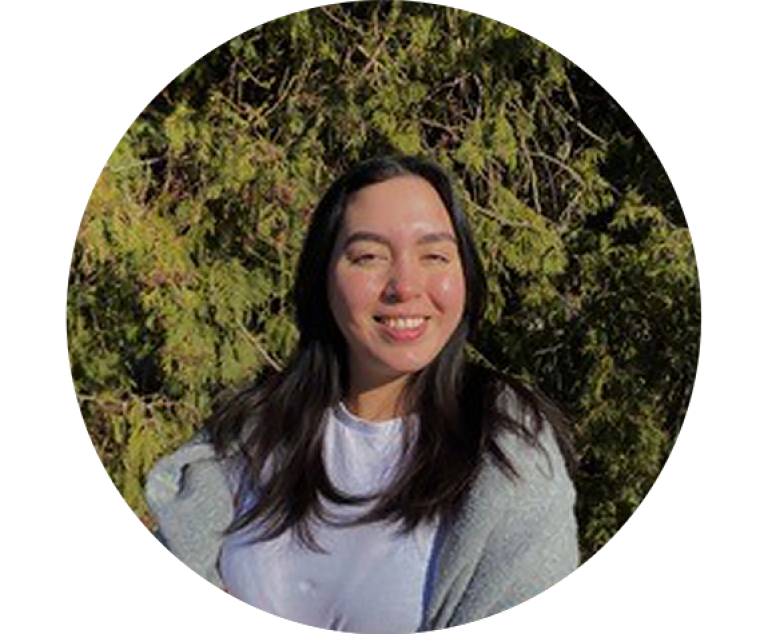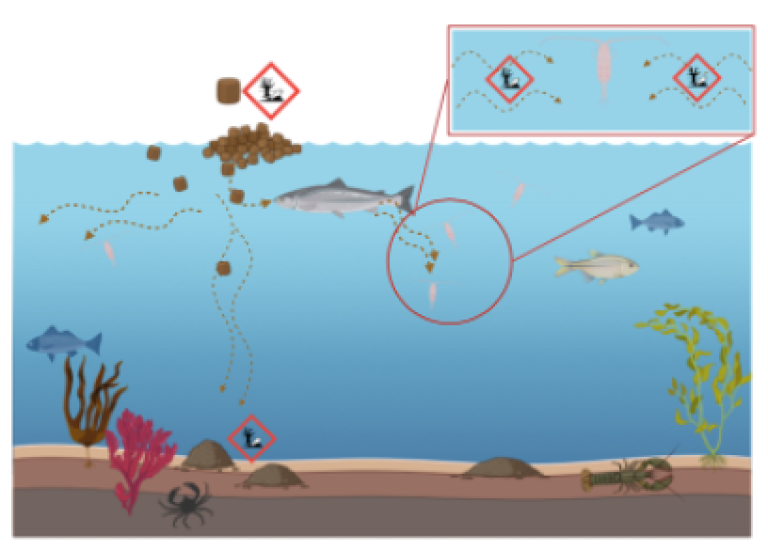News
Master thesis submitted by Celine Vågå! Congratulations!

As climate change and human activities intensify in the Arctic and boreal regions, understanding
the environmental impact of anthropogenic chemical pollution becomes essential. In the aquaculture industry, chitin synthesis inhibitors (CSI) like teflubenzuron are used to combat parasitic copepods, such as salmon lice, in farmed fish. However, the utilization of the chemical may exert unintended effects on non-target marine organisms, such as the copepod Calanus finmarchicus.
Celine Våga has submitted her thesis in Environmental Science at NMBU on this topic as a part of the EXCPECT project with Knut Erik Tollefsen and Li Xie as a part of her supervisory team. The thesis extends previous research by examining the effects of teflubenzuron on the molting process of C. finmarchicus through a combination of sub-acute exposure study and gene expression analysis.
Key findings reveal that teflubenzuron concentrations of 0.0127 µg/L and higher may hinder normal development, cause severe morphological deformities, and lead to molting-associated mortality in C. finmarchicus. This study is a novel contributor to the work of expanding AOP 360 toward encompassing key arctic species. Additionally, the findings from this work can expand our understanding of the impact of chemical pollution on marine life.

Interview - Impressions of Svalbard
We recently interviewed Maria Hultman, the winner of the EXPECT logo competition who was awarded a trip to Svalbard!
What motivated you to participate of the logo competition at the first place? And what do you think about those types of contest under research projects?

Maria: I am a creative person and participated in the competition as I wanted the overall goal of project to be translated into a graphical representation.
I really liked the idea of the contest as it was a motivation for a wider public of national and international people to contribute.
What was your overall impression of Longyearbyen? What did you like the most and what did you dislike?
The impression I got of the town was its youth, both buildings and its inhabitants. The town itself and vibes mediated ephemerality. Many young inhabitants in their 20-30ies, lived, studied and worked there for only a short period of time. I visited Longyearbyen during low season, so there were not too many tourists there at the time, which I can imagine is quite intense, as the town is very small. I liked that Longyearbyen has conserved its history of mining, and early settlement. I disliked Longyearbyen as it mediates the impression of forcing itself into this raw, pristine and dramatic arctic landscape. To be honest it feels like it does not belong there, being merely a temporary settlement.

Talking about the environment and considering Longyearbyen as a representative example of an urban settlement in the Arctic landscape: What are the main polluting activities, in your opinion?
Locally, I would say it is the settlement itself, the tourism industry, coal mining activities and satellite installment. Before the installment of a wastewater treatment plant in December 2022, all waste water produced by Longyearbyen went straight into Adventfjord. In my opinion this would create potentially local issues for wildlife in and around the discharge area as several chemical compounds, pharmaceuticals and personal care products have the potential to bioaccumulate and biomagnify in the food web. This has indeed been reported in other settlements in Svalbard, where high levels of pharmaceuticals have been reported in wildlife in Kongsfjorden, a body of water close to Nye-Ålesund wastewater discharge area. In addition anthropogenic pressure is added to the environment with the tourism industry, as large cruise ships pollute the surrounding area (e.g. untreated waste water, spill of fossil fuel), smaller tourist boats and land-based activities frequently occur in Svalbard.
The landscape in and around Longyearbyen display a lot of reminiscence of old pollution sources, like coal mining. There is only one active Norwegian mine remaining in Svalbard, located 15 km southeast of Longyearbyen, mine No. 7, where almost 73% (80 000 tons of total 110 000 tons) of the extracted coal is annually exported to European industries, and will be actively extracted until at least 2025. In addition to the Norwegian mining activities, there are mines close to the Russian settlement of Barentsburg, where in 2018, 140 000 tons of coal were removed from under the permafrost, exporting 79% to Great Britain. I find that the exploitation of the nature reserves is unnecessary, as the vast majority of the coal is being exported to other countries, leaving the Svalbard wildlife and nature with the ecological repercussions.

From what you could see or feel, do you think that they advertise themselves as a place to be protected? Or are they more interested in developments (deep-sea mining, aquaculture, oil, etc..)? Or a balance between both?
In my personal opinion I got the impression that Svalbard (mainly Longyearbye and the tourism industry) advertise themselves as a tourist attraction to experience the pristine arctic nature. Thus my impression is that they want to protect the environment and wildlife there. However, I know that there are continuous activities related to new installment and maintenance of the 140-150 satellite dishes in and around Longyearbyen. There has been a lot of interest from NASA regarding downloading and transfer of data from satellites in the polar orbit, which resulted in the “The Svalbard Undersea Cable System” which consists of an optical fiber cable connection established between Svalbard and mainland Norway. This is my opinion add more pressure on a already exposed wildlife and environment.
To understand that the environmental- and wildlife conservation for future generations to come depends on our conscious actions and decisions made today. There will not be any tourism in Svalbard if there is no unique wildlife left to be observed. We need to learn how to live and coexist with the nature, not exploit it unconsciously, ignoring the costs. Conserve, be conscious and coexist.

Thank you, Maria, for your reflections, and of course our wonderful logo!
New Mphil candidate!
Welcome Robin Kaur to EXPECT! In 2020, Robin completed her BSc (Hons) research into the responses of Synechococcus to environmental stimuli: Temperature, Light, and Reactive Oxygen Species at Newcastle University. Robin is continuing with microalgae research and will investigate the effects of chemicals and mixtures on R. baltica. For the EXPECT project, she is supporting the selection of high throughput small scale in vivo and in vitro approaches are suitable proxies for large scale Arctic eco-toxicity testing of single pollutants and their mixtures, whilst developing AEPs and AOPs for industrial use. This is vital research for EXPECT, as a need for experimental approaches that can reliably assess the potential impact of mixtures of environmentally relevant Arctic pollutants using relevant Arctic species is required.
Building PBPK modeling capacity
In Fall of 2022, Greg Langlois completed the physiologically based pharmacokinetic (PBPK) modeling in toxicology and risk assessment course offered by the University of Florida. The course focused on developing PBPK models using both proprietary and open-source software. Key concepts included a comprehensive understanding of mathematical descriptions of the fundamental toxicological principles of Absorption, Distribution, Metabolism, and Excretion, how to adapt PBPK models for different compounds, and how to calibrate and evaluate model performance. The concepts and skills developed during this course will be invaluable in developing novel models in support of the EXPECT project.
Kyoto-Vienna biomath workshop
In December 2022, Dr. Barkha Tiwari participated of the Kyoto-Vienna biomath WORKSHOP hosted by the Erwin Schrödinger Institute, Vienna, Austria.
In the event, mathematicians and biologists were presented to a platform which can provide a comprehensive overview of the various self-organization mechanisms operating at different scales and the mathematical models by which they can be described or explained. Barkha will be encouraged to apply her learnings from the workshop in the context of the EXPECT project.
You can watch the workshop presentations here: YouTube playlist.
New Postdoc for EXPECT!

Barkha Tiwari has started working as a postdoc on the project! Barkha will develop and use mathematical/statistical models for integrated data analysis. She will also be involved in the development of a Source to Outcome Predictor and establishing Next Generation Risk Assessments (NGRA) tools. Welcome!
Logo design competition
We are happy to announce the WINNER logo for the EXPECT project, pictured below. 😊 The winning logo was designed by NIVA's Maria Hultman. Congratulations!
Thank you all for participating in the competition. We received many great logos and ideas, and the jury had a hard time narrowing the selection down to a few finalists. Thank you to all!
